Regular air exchange within the attic space and in the roofing system is essential for the long-term service of the roof and the building as a whole. Competently organized ventilation of the attic in a private house provides thermoregulation of the room. It will prevent the formation of mold, dampness.
In this article, we will consider why a flawlessly functioning air exchange in the attic space is needed. We will tell you about what ventilation systems are required for the complete removal of moisture and condensate. Let's get acquainted with the principles of the ventilation system, the options for its design.
When doing the work yourself, use the diagrams given, ventilation calculations, as well as useful photos and videos with tips for arranging ventilation systems.
The content of the article:
- What are the functions of ventilation?
- The nuances of the equipment of the air exchange system
-
Features of the organization of the ventilation system
- Spirits: location rules, calculations
- Installation rules for attic windows
-
Tips for arranging the engineering system
- Ventilation of a non-residential attic
- Warm attic: is air exchange necessary?
- Conclusions and useful video on the topic
What are the functions of ventilation?
The process of air exchange in a room is to regulate heat exchange processes and maintain optimal environmental indicators - temperature, humidity level, air speed masses.
The engineering system, equipped in accordance with the established technical requirements, provides free flow of air flows, its movement in space due to the installed dormer windows, air vents, aeration devices of various designs and others holes.
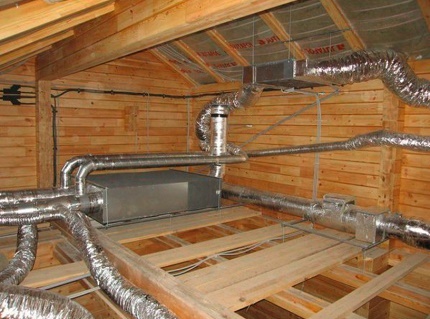
A normally operating ventilation device is necessary especially if equipment for a supply and exhaust ventilation system or ducted air conditioner is located within the non-residential space. If the condensate settling on it is not discharged in a timely manner, it will have to be repaired very often.
The functional purpose of the system is the regular supply of the required volume of air and its subsequent removal, which contributes to:
- decrease in moisture in the room;
- providing the necessary microclimate;
- preventing the formation of condensation and the development of fungus;
- creating continuous air exchange;
- preventing deformation of the rafters in the building.
The organization of ventilation should be carried out both in a warm and in an uninsulated attic. In summer, the surface of the roof heats up to high temperatures, transferring most of the heat to the lower part of the house.
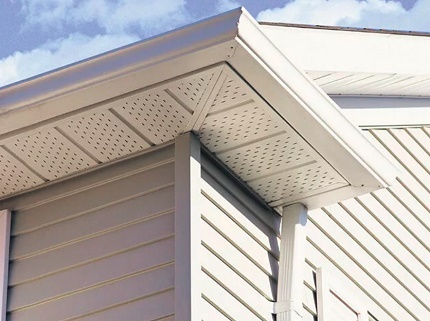
In the presence of ventilation devices, the temperature indicators inside the entire building decrease, which reduces the load on the air conditioning system, if any.
High humidity in autumn- the winter period affects the microclimate of the attic. At the same time, the thermal insulation qualities of the structure will be significantly reduced, because the water contained in the insulation and materials will contribute to heat loss. Therefore, to remove excess moisture, an air exchange system is equipped.
Due to the large temperature difference inside and outside the room, condensation forms, walls, floor, floor beams, rafter legs, Mauerlat, vertical racks get wet. All this leads to rotting of the wooden components of the roof, the appearance of dampness.

Due to the difference between the temperature outside the roof and within the attic space, condensation forms on the inner surface of the roof or in the insulation. It must be removed by ventilation.
For effective ventilation of the room throughout the year, without loss of heat in the house, the following technical standards are provided: for every 500 m2 premises need 1 m2 ventilation openings.
In addition, in order to prevent the formation of water droplets on the beams of the structure, insulation measures should be taken - lay steam- and water protection.
The nuances of the equipment of the air exchange system
In the organization of roof ventilation, one or more organization methods are used. Air exchange directly depends on the characteristics of the attic space, its area, shape, type of roof and building materials used.
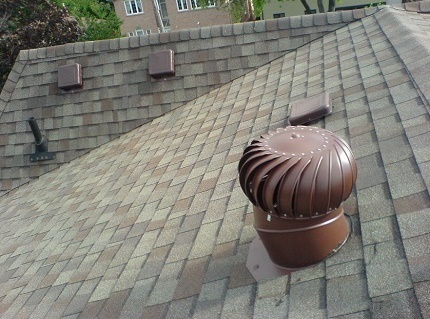
When installing the system, it is necessary to take into account the amount of precipitation typical for the region. If there is a risk of snow falling on the ridge and hip ridges, it is better to supplement the usual air vents with turbine aerators that exceed the height of snow drifts.
The specificity of the roof ventilation device is that it is necessary to provide two directions indirectly related to each other, these are:
- Roof cake ventilation. It is needed to dry the system under the roofing: insulation laid along the slopes, rafters, battens. Provided with air vents and aerators.
- Removing excess moisture from the attic space. It is required to drain the attic or attic, to form a microclimate in it that is favorable for extending the service life of the structure and the stay of the owners. Provided ventilation gable windows, holes, hatches.
The roofing cake is ventilated by vents - longitudinal channels laid from the eaves to the ridge ridge. The air is formed during the laying of the battens and counter battens on the rafter legs.

In the ventilation ducts formed by the crate - air vents - the air moves from bottom to top. It is tightened in the area of the cornices and brought out in the area of the ridge from the side or top
The distance created by this method allows the air flow to enter the cornice area and exit in the ridge area, taking with it condensate and moisture that has settled under the roof.
For roofing from ondulina, bituminous, polymer-sand and natural tiles additionally use aerators that follow the shape of the roofing material. If they do not differ in color, then they literally merge with the roof. The grill built into them allows the air to move freely in the direction necessary for drying.

Tile roof aerators can virtually “blend” into the coating. They are used mainly on hip, semi-hip and hip roofs, in which the ridge rib is shortened or not at all
In the case of a roof of the roof with corrugated steel, metal tiles and corrugated board, when installing a ventilation system for a roofing pie, it is somewhat complicated. The installation of the battens should be carried out with breaks, i.e. with additional transverse channels.
If the gap in the lathing was not initially observed, then side holes are drilled in the laths under the steel profiled roof. They are placed after about 30 cm. As a result, the area of the air flow drying the insulation increases due to the movement of air not only upwards, but also sideways.
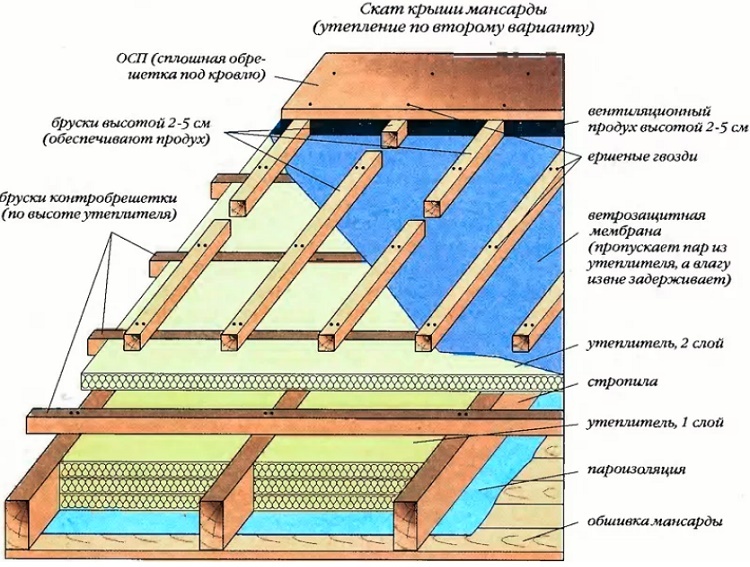
A batten with a break in the laying or with cross drilled holes increases the area covered by the air flow. So the insulation of the roofing cake is washed by air currents moving both along the slopes and across
Air exchange in houses with flat roofs is characterized by the absence of gables in which attic windows can be installed. And although there is still an attic in well-arranged flat and low-pitched roofs, they are ventilated through the ventilation holes.
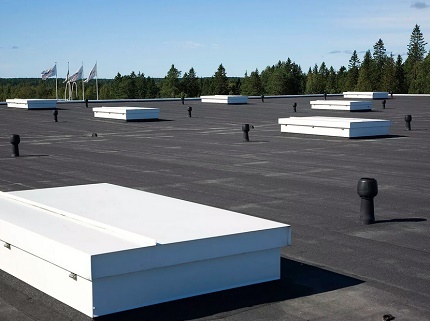
The roofing cake of a flat roof is ventilated with a system of aerators, the installation step of which depends on the thickness of the insulation and the area to be treated
The space in large hip roofs is ventilated through dormer ventilation windows, in small ones - through ventilation vents.
Despite the fact that the inclined ribs of the hips are equipped according to the ridge principle, they cannot provide sufficient outflow. To relieve and eliminate possible stress, aerators are installed.
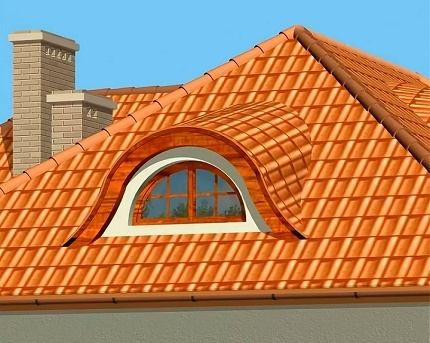
For ventilation of attic spaces and mansard rooms of hip and hip roofs, dormer windows are arranged. They can be with drop-down doors or with a fixed grille
Air exchange in the attic space of a gable roof is often organized by means of ventilation openings with grilles, as well as through ventilation or dormer windows. For natural circulation of air flow, both openings and window openings should be located on both sides.
Features of the organization of the ventilation system
For the correct functioning of the system, the following recommendations should be followed:
- For the free flow of air under the roof, it is necessary to leave special holes and gaps.
- Organize the air exchange system in such a way that air masses come from the bottom of the roofing cake and exit through a distance gap in the ridge ridge.
- Place a sufficient number of ventilated devices, openings, taking into account the area of \ u200b \ u200bthe room to ensure free movement of air in the attic.
- Ventilation ducts must be equipped with dampers in order to be able to regulate the intensity of ventilation, as well as mosquito nets to prevent insects from entering.
Holes in the ridge, under the eaves, provide circulation due to the force of the wind and the thermal movement of the masses that circulate naturally in the atmosphere.
Spirits: location rules, calculations
In a properly arranged roofing cake, the air movement is directed from below through the vents, and then up to the ridge with holes. Along the line of the ridge, a gap of 3-5 cm must be left, which is closed from above with a ridge strip, a number of ridge tiles, two mating boards and similar devices.
If the ridge is hermetically sealed, which prevents air from escaping, then ventilation holes are made in the pediment just below the ridge girder. They do not negate the need to arrange gable and dormer window openings, because different ventilation problems are being solved.
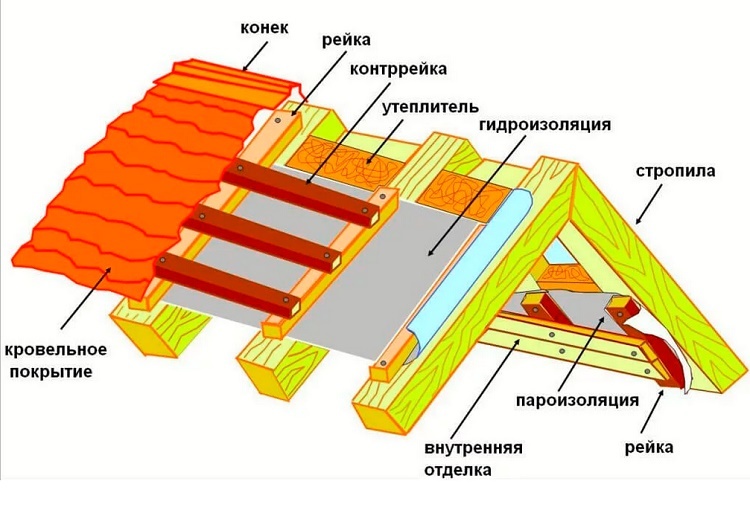
The air is formed by installing the battens and counter battens on the rafters. They at the same time form the distance between the insulation and the vapor barrier from the inside, the insulation and the waterproofing outside of the roofing cake.
Regardless of the type of roofing, almost all roofing pies are supplied with air. They are suitable both in insulated roofs of mansards and in cold structures without thermal insulation.
Below, along the eaves, the whole cake, together with these ventilation ducts, is covered with a mosquito net, which at the same time protects it from dust.
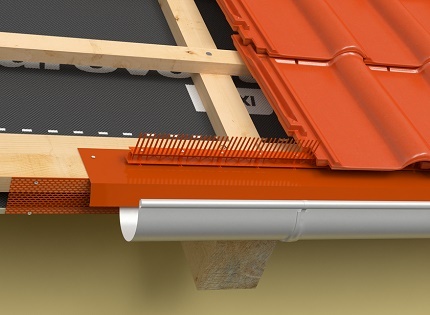
The air in the roofing cake is covered with a mosquito and aeration mesh. They allow air to pass freely, but keep insects, small birds, foliage, debris of branches, dust
In addition to the air vents laid in the roofing pie, there are also holes located in the upper part of the wall, along its line of conjugation with the slope.
Wall vents are divided into the following types:
- slotted, about 20 mm wide - located on both sides of the cornices, forming a gap between the wall and the roof;
- point, with a diameter of not more than 25 mm - they look like holes on the surface, the size of which depends on the slope of the slopes.
The specified size of the devices is important to observe when arranging ventilation system. Smaller or larger openings will reduce the efficiency of air circulation.
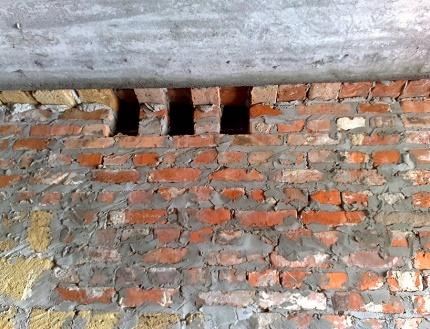
If it is impossible to arrange holes in the gables and install dormer windows to ventilate the attic, wall ventilation ducts are arranged in the walls under the roofing system
The width and number of holes may vary depending on the size of the roof. For regular and correct ventilation without unnecessary heat leakage from the room, the total area of the attic must be 0.2% of 100% of the room area. Also, do not forget about the correct location.
An example of calculating airflows when installing in a roofing pie:
- for a 5-meter roof, the holes must be 8 mm;
- 6-meter - hole width no more than 10 mm;
- with a roof width of 7 to 8.5 m, the airflow should be 12-14 mm;
- the roof with a width of 9-10 m is equipped with 16 mm ventilation holes.
If the vents are located in the lower part and on the ridge, their width should be halved. It is not recommended to exceed the permissible hole area as precipitation can enter them.
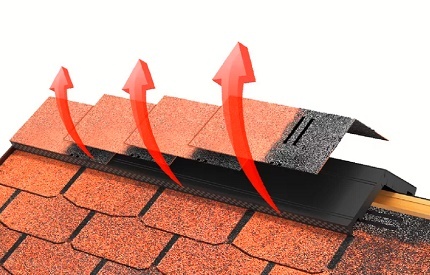
The roof slopes are not joined together, leaving a gap along the ridge ridge. It is closed with a ridge aerator, a set of tiles or a ridge bar
The vents in the upper part of the roof are intended for the suction outlet of the streams. Their area should be 15% larger than the supply air ducts. For this, aerators or special grids are used - more innovative devices that provide the required temperature difference and pressure level when air moves.
Installation rules for attic windows
When equipping an attic with dormer or ventilation windows, you will still need to prepare air vents and vents in addition. This option is considered highly effective, since moisture not removed from the roofing cake will interfere with the full ventilation of the premises.
To improve circulation, reduce air stagnation, the dimensions of the attic ventilation devices in a private house should be 600 × 800 mm.
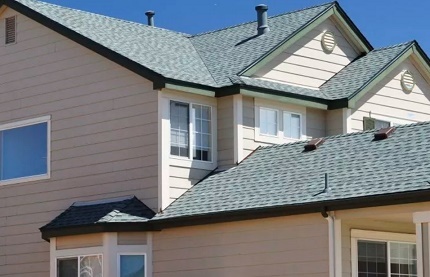
The gables of low-pitched roofs do not allow a full-fledged window to be arranged in them. In houses with gable sloping roofs, ventilation windows with a stationary or opening grille are arranged
Stages of installing attic windows:
- Wooden frames are attached to the rafters using racks.
- Next, the roofing is laid.
- The openings are finished with clapboard or other material.
- After that, the window frame is mounted in the prepared opening.
- After fixing the frame, it is necessary to eliminate all gaps between the roof and the window using polyurethane foam.
- The glass unit should be inserted last.
The installation of attic windows can be done independently according to the instructions or you can use the services of specialists.
When installing a window, you must adhere to some recommendations:
- should not be placed close to the skate;
- additionally they can be equipped with a grill;
- interwindow gaps should not exceed 1 m;
- it is necessary to position the devices in this way: the lower border of the window should not be lower than 1 m from the floor level, the upper one should not be more than 1.9 m.
Their designs can be varied. Basically, builders select the shape of the ventilation device depending on the type of building and architectural idea.
Tips for arranging the engineering system
To determine the level of complexity of work during the installation of the system, we will consider the features of ventilation of an insulated residential and not equipped cold attic space. Let's figure out what are the differences in the organization of air exchange with different types of room insulation and temperature conditions.
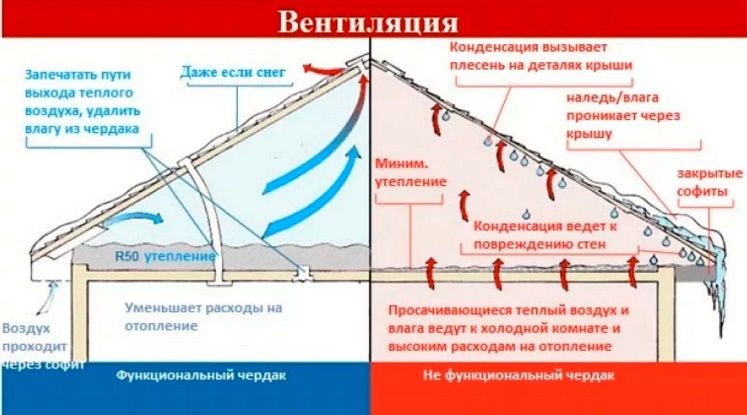
Ventilation devices in the attic perform the function of thermoregulation of the entire building. With proper installation, air vents and attic windows will reduce heating costs and provide the necessary level of cooling in summer
Air exchange helps to extend the service life of the roof, rafter frame, equipped and not equipped rooms under the slopes. The system also prevents the accumulation of snow, icing on the roof, and the formation of moisture.
Ventilation of a non-residential attic
A cold attic not equipped for living is a space under the roof without insulation and finished walls, a floor that serves as a technical floor. However, it also needs to be equipped with a ventilation system.
It is optimal to deal with this issue at the stage of project development and construction. For air circulation, the rafters and gratings should be left partially open.
Various devices are used to organize the movement of air. For the inflow - soffits with small holes, which cover the overhangs from the bottom up to the wall of the house. The special design prevents debris and insects from entering the room, but allows air masses to flow freely.

If it is not possible to equip the eaves overhangs with soffits, they are sewn up with corrugated board with perforated elements or a regular board, leaving ventilation gaps between the elements
The panels are produced in several modifications. The most common types of products:
- solid - used for installation on gazebos, verandas, terraces;
- perforated in the center - placed on the fronts, eaves overhangs of roofs;
- fully perforated - designed for roofs covered with bituminous tiles.
When covering the roof with slate, ondulin, without the use of insulation materials, natural air exchange will occur. Therefore, in the attic, you do not need to organize a special ventilation system.
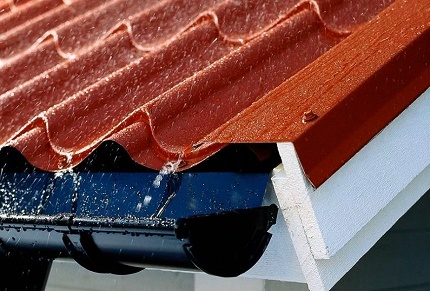
The end of a metal-tile and tile roof, corrugated board, ondulin is not closed along the eaves. In the area of the ridge, before laying the coating, a porous polymer tape is installed, freely passing air flows
Gable roofs are most often equipped with ventilation ductsplaced in the fronts. If there are small gaps in the overhangs, air circulation will occur correctly.
If the lining is tightly attached to the eaves, you will need to make several holes, according to norms for the organization of ventilation, or install special grids with grids with a step of 80 cm along the entire overhang.
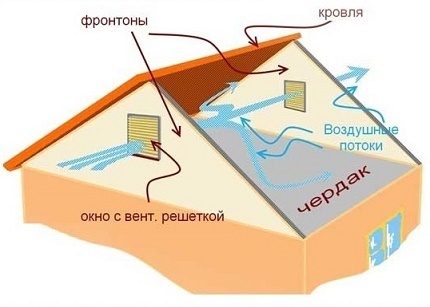
Ventilation of the attic space of the pitched roof is provided by windows or openings arranged in the gable or gable of the gable structure. If they are equipped with glazed doors, volley ventilation should be carried out periodically.
When arranging an air exchange system, it is necessary to take into account the design features and shape. For a certain type of roof, a variety of ventilation elements are used.
For the effective operation of the engineering system, devices are needed not only for the inflow, but also elements that will remove the spent air masses. In practice, various options are used - deflectors, make the ridge ventilated, leave a gap around the perimeter of the roof, and others.
Warm attic: is air exchange necessary?
The attic space is an integral part of the house, which can be used as an additional area for permanent residence. However, this will require not only insulating it, but also competently organizing the ventilation system.
For the attic, they design and arrange everything as they usually do in the organization. ventilation of a two-story house. You should think over the design in detail and select the necessary air exchange elements, taking into account the area of the attic.
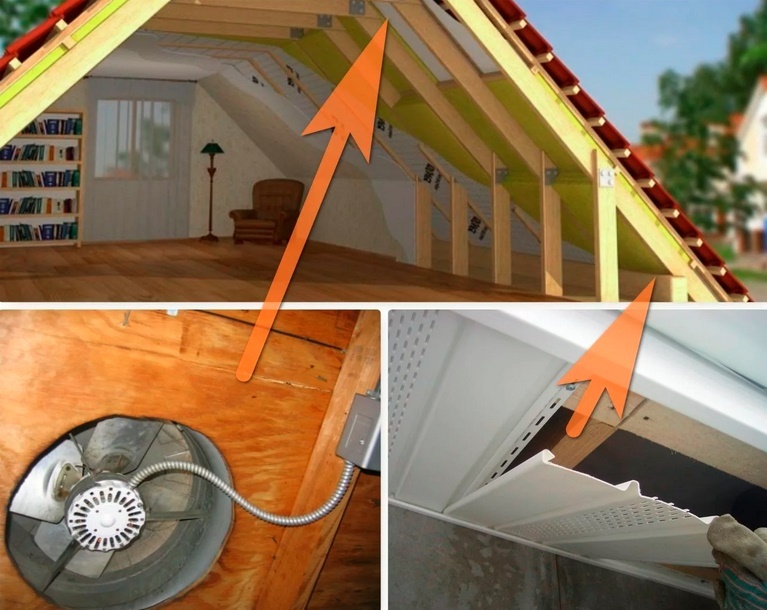
The space of the equipped attic is ventilated like an ordinary room. Windows are opened for ventilation. If they cannot cope, supply and exhaust valves with fans are installed in the slopes.
Consider the basic schemes for equipping ventilation for various types of roofs:
- From sheet material, flexible tiles - they equip a ventilated area by patching a strip on a solid sheathing of plywood or OSB boards.
- From metal tiles - it is recommended to use the lathing along the rafters.
- Slate, ondulina - no need for free air intake and outlet counter-lattice. The material is attached to the lathing, which will form a distance for the free entry of air flow at the eaves and exit through the ridge.
In modern homes, aerators are installed to remove exhaust air. The devices prevent the formation of condensation, and also prevent the penetration of precipitation into the room.
The living area should be as ventilated as other areas. Air masses enter through the attic windows and additional valves, and exit through the overhead ventilation devices.
For the correct ventilation of the residential attic floor, use the following scheme:
- place pipes with a deflector on the roof;
- ventilation grilles are installed in the pediments;
- in the upper part of the roof or outer wall have thermally insulatedventilation duct.
For installation of air exchange elements on the roof, it is necessary to use only durable products that are resistant to gusts of wind and precipitation.
Conclusions and useful video on the topic
Popular methods of ventilation to remove condensation:
Organization of room ventilation by making ventilation holes in the pediment:
Tips for arranging an air exchange system within the attic under a cold roof:
Arrangement of attic ventilation in a private house is a mandatory procedure. It is important to pre-calculate the number of required holes and devices for air circulation. Since the indoor climate deteriorates with low system efficiency, there is a risk of destruction of roof structures and a reduction in the service life of the building.
Please write your comments in the block form below, ask questions on the topic, post photos. Share useful information that site visitors should learn. It is possible that your recommendations will help to cope with the problem of dampness and condensation in the attic.


